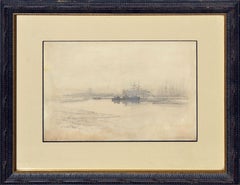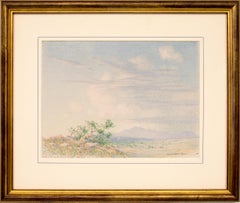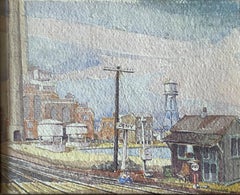Raymond Dabb Yelland Landscape Drawings and Watercolors
Raymond Dabb Yelland was born in London, England in 1848. At the age of three, he immigrated with his family to New York City, where he was raised and attended public schools. By the age of 12, he had settled on art as a career. He was born as Raymond Dabb, but due to the negative connotation of his name, his mother's maiden name, Yelland was added. After serving under Sheridan in the Federal Army during the Civil War, Yelland attended Pennington Seminary in New Jersey. He studied art at the National Academy of Design from 1869 to 1871 with Page and Brevoort, and then taught at the academy for one year. With his new bride, he sailed around the Horn in 1874 to San Francisco, where he would assume the position of an art instructor at Mills College in Oakland.
In 1877, Yelland traveled to England and later continued his studies in Paris with Luc Oliver Merson. Upon his return to California, Yelland became assistant director of the San Francisco School of Design, and in 1888, assumed its directorship. While at that school, he also taught at the University of California, Berkeley, for many years. His many pupils included Homer Davenport, Alexander Harrison, Maynard Dixon and other noted artists. At his summer home on the Monterey Peninsula, he painted many coastals, whereas the marshes near his home in Oakland also provided ample subject matter. A master at depicting sunsets and other atmospheric glow, his painting technique was a fusion of American Luminism and the Hudson River School. Yelland maintained a studio in Carmel, California as well as in San Francisco at 430 Pine Street until his death of pneumonia at his home at 1464 7th Avenue, Oakland, in 1900. His exhibitions include the San Francisco Art Association, 1874–1900; Paris Salon, 1877; Mechanics' Institute (SF), 1875–97; California State Fair, 1879–1901; National Academy of Design, 1880; World's Columbian Expo in Chicago, 1893; California Midwinter International Exposition, 1894; Oakland Industrial Exposition, 1896; Mark Hopkins Institute (SF), 1897; Alaska-Yukon Exposition (Seattle), 1909. His works can be seen at the Santa Cruz City Museum, the Monterey Peninsula Museum, the Oakland Museum, the First Congregational Church in Oakland, the Bancroft Library at UC Berkeley and the California Historical Society.
1880s American Impressionist Raymond Dabb Yelland Landscape Drawings and Watercolors
Paper, Pencil
1880s American Impressionist Raymond Dabb Yelland Landscape Drawings and Watercolors
Color Pencil
1910s American Impressionist Raymond Dabb Yelland Landscape Drawings and Watercolors
Paper, Watercolor
1910s American Impressionist Raymond Dabb Yelland Landscape Drawings and Watercolors
Graphite
Early 20th Century American Impressionist Raymond Dabb Yelland Landscape Drawings and Watercolors
Color Pencil, Paper
1910s American Impressionist Raymond Dabb Yelland Landscape Drawings and Watercolors
Pencil
Mid-20th Century American Impressionist Raymond Dabb Yelland Landscape Drawings and Watercolors
Paper, Oil Pastel
1910s American Impressionist Raymond Dabb Yelland Landscape Drawings and Watercolors
Graphite
21st Century and Contemporary American Impressionist Raymond Dabb Yelland Landscape Drawings and Watercolors
Paper, Gouache
Early 20th Century American Impressionist Raymond Dabb Yelland Landscape Drawings and Watercolors
Paper, Watercolor
Mid-20th Century American Impressionist Raymond Dabb Yelland Landscape Drawings and Watercolors
Paper, Oil Pastel
Early 20th Century American Impressionist Raymond Dabb Yelland Landscape Drawings and Watercolors
Watercolor, Pencil
Mid-20th Century American Impressionist Raymond Dabb Yelland Landscape Drawings and Watercolors
Paper, Oil Pastel


